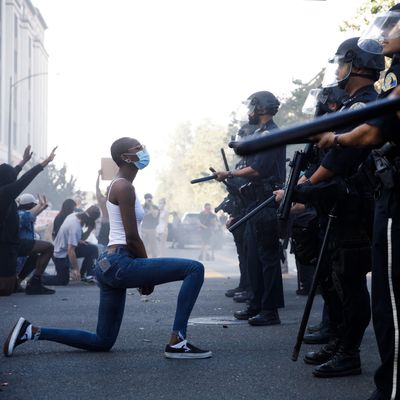
Most weeks, New York Magazine writer-at-large Frank Rich speaks with contributor Alex Carp about the biggest stories in politics and culture. Today, national unrest since the death of George Floyd.
The nationwide protests following the death of George Floyd in police custody have continued for a week, with no end in sight. Are we, as some journalists, historians, and politicians have suggested, at a crossroads of American democracy?
When James Clyburn, the 79-year-old South Carolina congressman, described America as being at a “crossroads” in an interview with CNN’s Anderson Cooper on Tuesday, his tone was matter-of-fact. He was low key, even plaintive, when he added that the “future of this country is really at stake” and that its “demise” is not out of the question. Clyburn, a pillar of Washington for nearly three decades, is no hothead, and what sane person would not agree with his remark? Before the murder of George Floyd, the nation’s prevailing political question was, Can Trump be beaten in November? It has now been supplanted by an existential question: Can this country even hold itself together and limp through a long hot summer to Election Day?
The waves of pestilence that have swept over America leave one anxiously searching for historical analogies. Is this 1968, when the nation’s cities broke out in violence after the assassination of Martin Luther King, when Chicago’s police rioted and maimed anti-war protesters at the Democratic National Convention, and when Richard Nixon and Spiro Agnew embraced “law and order” and stoked racial animus in a “Southern strategy” to win the election? Or could it be 1968 combined with 1929 (the Great Depression) and 1918 (the Spanish Flu)? We’re not even at the halfway point, and already 2020 seems to lack few horrors, with the possible exception of locusts. (Though killer hornets may be on tap.)
But you could also say that likening this year to any other is to miss the larger point about the perilous state of the American experiment. The intractable issue of race in this country has been a festering cancer each and every year of its existence, even when it seems to go into remission — whether the “victory” over America’s original sin be marked by the Emancipation Proclamation, the legislative triumphs of the Civil Rights Movement, or the election of the first African-American president. It’s only human to want to believe that history moves forward in our own lifetimes, and that we can cite milestones we’ve witnessed with our own eyes to measure that progress. But history is bigger than all of us, and from the perspective of its wide lens, America is still a young country, perennially stuck in a nightmarish Groundhog Day since its birth.
Take a small example from 1967. After urban riots left 43 dead in Detroit and 26 in Newark. Lyndon Johnson, the president who fought tirelessly to redress the nation’s racial and economic inequities, created a National Advisory Commission on Civil Disorders to investigate what had happened. The Kerner Commission, named after the Illinois governor who chaired it, produced a voluminous report that was published and promptly ignored as the country melted-down in 1968. Its 600-plus pages in my old paperback edition can be reduced to a single finding on page eight: The No. 1 cause of the unrest was “Police Practices,” which resulted in “a widespread belief among Negroes in the existence of police brutality and in a ‘double standard’ of justice and protection – one for Negroes and one for whites.”
It was late in 1967, as the Kerner commission was reaching this conclusion, that the police chief of Miami, Walter Headley, responded to his city’s unrest by declaring “war” on criminals, vowing to go after them with shotguns and dogs, killing them if need be: “I’ve let the word filter down that when the looting starts, the shooting starts,” he said. The coinage was echoed by the white supremacist third party candidate of 1968, the Alabama governor George Wallace, who would win five Southern states and come close to throwing the tight presidential election into the House of Representatives.
It was, of course, Headley’s message that Trump revived in his tweet last weekend — though in Trump’s case, it turned out that he was willing to inflict violent punishment even on those who are not looting. He and his attorney general Bill Barr unleashed rubber bullets and gas on peaceful protesters, including clergy, to clear the stage for the photo op in which he held up an upside-down Bible that had been carried to St. John’s Church by his daughter in a $1,540 Max Mara handbag. This religious tableau was carried out by the President with an all-white cadre that included the Secretary of Defense and the Chairman of the Joints Chief of Staff. Soon the internet was flooded with photoshopped images of Hitler staging a similar Bible-toting photo op, and within 48 hours even Jim Mattis, the esteemed retired General and former Trump Secretary of Defense, released a statement likening his former boss’s divisive rhetoric to the Fuhrer’s.
Most Vichy Republicans in Washington are remaining silent even so — unless you count the Arkansas senator Tom Cotton, who did his part to uphold Walter Headley’s legacy by calling for American troops to go to war against their own citizens to restore order. Unlike Trump, he took the trouble to pretty up Headley’s words a bit by fashioning them into an Op-Ed piece that the Times saw fit to publish — on grounds redolent of Facebook — despite its bloodthirsty tenor and its inclusion of a discredited Antifa conspiracy theory to justify its call for martial law.
No one should be surprised that the latest public lynching of a black American by the police — and almost literally a lynching, with a cop’s knee substituting for the rope — led to this conflagration. We’ve been there too many times before. Feckless liberals who did little or nothing as police abuses piled up on their watch, whether Amy Klobuchar in Minnesota or Bill de Blasio in New York, have zero excuse.
The legions of Republicans in public office who stand idly by as Trump and his MAGA claque of racists occupy the White House are indistinguishable from their forebears — whether Democrats of the Jim Crow era, or their successors, the Republicans who took up the segregationist mantle from the Dixiecrats once Barry Goldwater ran for president in opposition to the Civil Rights Act in 1964. They can’t pretend now that they didn’t know Trump’s intentions from the start. Barely a month after his Inaugural address decrying “American carnage,” his attorney general, Alabama’s Jeff Sessions, started to dismantle Justice department programs monitoring rogue police departments. “We’re going to try to pull back on this, and I don’t think it’s wrong or mean or insensitive to civil rights or human rights,” he said in February 2017. Just five months later Trump gave an address to uniformed police in Long Island in which he asked that they “please don’t be too nice” when manhandling criminal suspects.
We’ve got American carnage now, all right. What happens next? In some ways, 2020 looks more like 1868 than 1968. That was the year when the racist president Andrew Johnson, who’d inherited the White House after Lincoln’s assassination, narrowly escaped conviction at his Impeachment trial. In the ensuing presidential race, the Republican party cleansed itself by nominating Ulysses Grant. The racial animus of the Democrats’ ticket was defined by the vice presidential candidate, Francis Blair. As the historian Richard White writes in The Republic for Which It Stands, he “promised to use the army to restore ‘white people’ to power in the South” by nulling the new state governments controlled by what he called the “semi-barbarous race of blacks” who had been empowered by the Reconstruction Act of a year earlier.
“The election of 1868 in the South was one of the most violent in American history,” White writes, a “reign of terror” targeting black voters. In Florida, for instance, bands of white men armed with guns kept blacks from voting. It was “the last presidential contest to center on white supremacy,” wrote the historian Eric Foner in his definitive account of the period, Reconstruction. The Democrats’ incendiary campaign raised “the specter of a second Civil War.”
Grant triumphed. America was spared that second Civil War, albeit without eradicating the systemic toxins that have deprived black citizens of their lives, their rights, and economic equality ever since. Now we have another election that is centered on white supremacy, with a president and a major political party, abetted by the John Roberts Supreme Court, determined to do anything possible to block what Trump calls “the black people” from access to the one peaceful method for going forward, the ballot box.
“There is no such thing as rock bottom,” wrote George Will this week. “So, assume the worst is yet to come.” What form will that take? We know by now that 40 percent of the public and, George Will notwithstanding, 99 percent of Republican leaders and financial backers will remain loyal to Trump no matter what. We know that none of them complained when their voters, who define “liberty” as their right to spread new lethal waves of COVID-19 with impunity, carried assault weapons into state capitols. We know that Trump pointedly vowed yet again to “protect the rights of law-abiding Americans, including your Second Amendment rights” in his brief Rose Garden address ostensibly deploring George Floyd’s murder before marching to St. John’s church on Monday.
You don’t need to be woke, only awake, to see what’s going on here and to ask once again, more desperately than ever, why Trump’s toadies in Washington continue to do nothing as our country teeters toward the abyss.






























